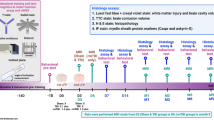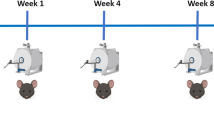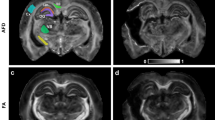Abstract
Brain injury in sickle cell disease (SCD) comprises a wide spectrum of neurological damage. Neurocognitive deficits have been described even without established neurological lesions. DTI is a rapid, noninvasive, and non-contrast method that enables detection of normal-appearing white matter lesions not detected by conventional magnetic resonance imaging (MRI). The aim of the study was to evaluate if stem cell transplantation can revert white matter lesions in patients with SCD. Twenty-eight SCD patients were evaluated with MRI and DTI before and after allogeneic hematopoietic stem cell transplantation (HSCT), compared with 26 healthy controls (HC). DTI metrics included fractional anisotropy (FA), mean diffusivity (MD), radial (RD), and axial (AD) diffusivity maps, global efficiency, path length, and clustering coefficients. Compared to HC, SCD patients had a lower FA (p = 0.0086) before HSCT. After HSCT, FA increased and was not different from healthy controls (p = 0.1769). Mean MD, RD, and AD decreased after HSCT (p = 0.0049; p = 0.0029; p = 0.0408, respectively). We confirm previous data of white matter lesions in SCD and present evidence that HSCT promotes recovery of brain injury with potential improvement of brain structural connectivity.
This is a preview of subscription content, access via your institution
Access options
Subscribe to this journal
Receive 12 print issues and online access
$259.00 per year
only $21.58 per issue
Buy this article
- Purchase on Springer Link
- Instant access to full article PDF
Prices may be subject to local taxes which are calculated during checkout




Similar content being viewed by others
References
Piel FB, Steinberg MH, Rees DC. Sickle cell disease. N Engl J Med. 2017;376:1561–73.
Ware RE, de Montalembert M, Tshilolo L, Abboud MR. Sickle cell disease. Lancet. 2017;390:311–23.
Ohene-Frempong K, Weiner SJ, Sleeper LA, Miller ST, Embury S, Moohr JW, et al. Cerebrovascular accidents in sickle cell disease: rates and risk factors. Blood. 1998;91:288–94.
Ford AL, Ragan DK, Fellah S, Binkley MM, Fields ME, Guilliams KP, et al. Silent infarcts in sickle cell anemia occur in the borderzone region and are associated with low cerebral blood flow. Blood. 2018;132:1714–23.
Kassim AA, Galadanci NA, Pruthi S, Debaun MR, How I. How I treat and manage strokes in sickle cell disease. Blood. 2015;125:3401–10.
Debaun MR, Kirkham FJ. Central nervous system complications and management in sickle cell disease. Blood. 2016;127:829–38.
Kassim AA, Pruthi S, Day M, Rodeghier M, Gindville MC, Brodsky MA, et al. Silent cerebral infarcts and cerebral aneurysms are prevalent in adults with sickle cell anemia. Blood. 2016;127:2038–40.
Bernaudin F, Verlhac S, Arnaud C, Kamdem A, Chevret S, Hau I, et al. Impact of early transcranial Doppler screening and intensive therapy on cerebral vasculopathy outcome in a newborn sickle cell anemia cohort. Blood. 2011;117:1130–40.
Bernaudin F, Verlhac S, Fréard F, Roudot-Thoraval F, Benkerrou M, Thuret I, et al. Multicenter prospective study of children with sickle cell disease: radiographic and psychometric correlation. J Child Neurol. 2000;15:333–43.
Armstrong FD, Thompson RJ, Wang W, Zimmerman R, Pegelow CH, Miller S, et al. Cognitive functioning and brain magnetic resonance imaging in children with sickle Cell disease. Neuropsychology Committee of the Cooperative Study of Sickle Cell Disease. Pediatrics. 1996;97:864–70.
Pegelow CH, Macklin EA, Moser FG, Wang WC, Bello JA, Miller ST, et al. Longitudinal changes in brain magnetic resonance imaging findings in children with sickle cell disease. Blood. 2002;99:3014–8.
Noll RB, Stith L, Gartstein MA, Ris MD, Grueneich R, Vannatta K, et al. Neuropsychological functioning of youths with sickle cell disease: Comparison with non-chronically ill peers. J Pediatr Psychol. 2001;26:69–78.
Estcourt LJ, Fortin PM, Hopewell S, Trivella M, Doree C, Abboud MR. Interventions for preventing silent cerebral infarcts in people with sickle cell disease. Cochrane Database Syst Rev. 2017. https://doi.org/10.1002/14651858.CD012389.pub2.
Bernaudin F, Verlhac S, Arnaud C, Kamdem A, Vasile M, Kasbi F, et al. Chronic and acute anemia and extracranial internal carotid stenosis are risk factors for silent cerebral infarcts in sickle cell anemia. Blood. 2015;125:1653–61.
Hulbert ML, Mckinstry RC, Lacey JL, Moran CJ, Panepinto JA, Thompson AA, et al. Silent cerebral infarcts occur despite regular blood transfusion therapy after first strokes in children with sickle cell disease. Blood. 2011;117:772–9.
Arnold SD, Bhatia M, Horan J, Krishnamurti L. Haematopoietic stem cell transplantation for sickle cell disease-current practice and new approaches. Br J Haematol. 2016;174:515–25.
Simões BP, Pieroni F, Costa T, Barros GN, Darrigo G Jr, Grecco CS, et al. Allogenic bone narrow transplantation in sickle-cell diseases. Rev Assoc Med Bras. 2016;62:16–22.
Bolaños-Meade J, Brodsky RA. Blood and marrow transplantation for sickle cell disease: Is less more? Blood Rev. 2014;28:243–8.
Bhatia M, Sheth S. Hematopoietic stem cell transplantation in sickle cell disease: patient selection and special considerations. J Blood Med. 2015;6:229–38.
Gluckman E, Cappelli B, Bernaudin F, Labopin M, Volt F, Carreras J, et al. Sickle cell disease: an international survey of results of HLA-identical sibling hematopoietic stem cell transplantation. Blood. 2017;129:1548–56.
Bernaudin F, Verlhac S, De Latour RP, Dalle JH, Brousse V, Petras E, et al. Association of matched sibling donor hematopoietic stem cell transplantation with transcranial doppler velocities in children with sickle cell anemia. JAMA. 2019;321:266–76.
Kato GJ, Piel FB, Reid CD, Gaston MH, Ohene-Frempong K, Krishnamurti L, et al. Sickle cell disease. Nat Rev Dis Primers. 2018. https://doi.org/10.1038/nrdp.2018.10.
Jordan LC, Juttukonda MR, Kassim AA, DeBaun MR, Davis LT, Pruthi S, et al. Haploidentical bone marrow transplantation improves cerebral hemodynamics in adults with sickle cell disease. Am J Hematol. 2019;94:E155–8.
Balci A, Karazincir S, Beyoglu Y, Cingiz C, Davran R, Gali E, et al. Quantitative brain diffusion-tensor MRI findings in patients with sickle cell disease. Am J Roentgenol. 2012;198:1167–74.
Green NS, Bhatia M, Griffith EY, Qureshi M, Briamonte C, Savone M, et al. Enhanced long-term brain magnetic resonance imaging evaluation of children with sickle cell disease after hematopoietic cell transplantation. Biol Blood Marrow Transplant. 2017;23:670–6.
Beaulieu C. The basis of anisotropic water diffusion in the nervous system—a technical review. NMR Biomed. 2002;15:435–55.
Taoka T, Iwasaki S, Sakamoto M, Nakagawa H, Fukusumi A, Myochin K, et al. Diffusion anisotropy and diffusivity of white matter tracts within the temporal stem in Alzheimer disease: evaluation of the “tract of interest” by diffusion tensor tractography. Am J Neuroradiol. 2006;27:1040–5.
Pierpaoli C, Basser PJ. Toward a quantitative assessment of diffusion anisotropy. Magn Reson Med. 1996;36:893–906.
Song SK, Yoshino J, Le TQ, Lin SJ, Sun SW, Cross AH, et al. Demyelination increases radial diffusivity in corpus callosum of mouse brain. Neuroimage. 2005;26:132–40.
Wheeler-Kingshott AM, Barker GJ, Steens SCA, van Buchem MA. The diffusion of water. In: Tofts P, editor. Quantitative MR of the brain: measuring changes caused by disease. Hoboken, NJ: John Wiley & Sons, Ltd; 2003. p. 203–256.
Irimia A, Wang B, Aylward SR, Prastawa MW, Pace DF, Gerig G, et al. Neuroimaging of structural pathology and connectomics in traumatic brain injury: Toward personalized outcome prediction. Neuroimage Clin. 2012;1:1–17.
Kassim AA, Sharma D. Hematopoietic stem cell transplantation for sickle cell disease: The changing landscape. Hematol Oncol Stem Cell Ther. 2017;10:259–66.
Walters MC, Hardy K, Edwards S, Adamkiewicz T, Barkovich J, Bernaudin F, et al. Pulmonary, gonadal, and central nervous system status after bone marrow transplantation for sickle cell disease. Biol Blood Marrow Transplant. 2010;16:263–72.
Kawadler JM, Kirkham FJ, Clayden JD, Hollocks M, Seymour EL, Edey R, et al. White matter damage relates to oxygen saturation in children with sickle cell anemia without silent cerebral infarcts. Stroke. 2015;46:1793–9.
Sun B, Brown RC, Hayes L, Burns TG, Huamani J, Bearden DJ, et al. White matter damage in asymptomatic patients with sickle cell anemia: Screening with diffusion tensor imaging. Am J Neuroradiol. 2012;33:2043–9.
Dallas MH, Triplett B, Shook DR, Hartford C, Srinivasan A, Laver J, et al. Long-term outcome and evaluation of organ function in pediatric patients undergoing haploidentical and matched related hematopoietic cell transplantation for sickle cell disease. Biol Blood Marrow Transplant. 2013;19:820–30.
Stotesbury H, Kirkham FJ, Kölbel M, Balfour P, Clayden JD, Sahota S, et al. White matter integrity and processing speed in sickle cell anemia. Neurology. 2018;90:e2042–50.
Vichinsky EP, Neumayr LD, Gold JI, Weiner MW, Rule RR, Truran D, et al. Neuropsychological dysfunction and neuroimaging abnormalities in neurologically intact adults with sickle cell anemia. JAMA. 2010;303:1823–31.
Bhatia M, Jin Z, Baker C, Geyer MB, Radhakrishnan K, Morris E, et al. Reduced toxicity, myeloablative conditioning with BU, fludarabine, alemtuzumab and SCT from sibling donors in children with sickle cell disease. Bone Marrow Transplant. 2014;49:913–20.
Bush AM, Borzage MT, Choi S, Václavu L, Tamrazi B, Nederveen AJ, et al. Determinants of resting cerebral blood flow in sickle cell disease. Am J Hematol. 2016;91:912–7.
Bernaudin F, Socie G, Kuentz M, Chevret S, Duval M, Bertrand Y, et al. Long-term results of related myeloablative stem-cell transplantation to cure sickle cell disease. Blood. 2007;110:2749–56.
Schwartz RB, Bravo SM, Klufas RA, Hsu L, Barnes PD, Robson CD, et al. Cyclosporine neurotoxicity and its relationship to hypertensive encephalopathy: CT and MR findings in 16 cases. AJR Am J Roentgenol. 1995;165:627–31.
Noè A, Cappelli B, Biffi A, Chiesa R, Frugnoli I, Biral E, et al. High incidence of severe cyclosporine neurotoxicity in children affected by haemoglobinopaties undergoing myeloablative haematopoietic stem cell transplantation: early diagnosis and prompt intervention ameliorates neurological outcome. Ital J Pediatr. 2010;36:14.
Lebel C, Beaulieu C. Longitudinal development of human brain wiring continues from childhoo into adulthood. J Neurosci. 2011;31:10937–47.
Acknowledgements
The authors acknowledge the patients and their families, the medical and multidisciplinary bone marrow transplantation team, the blood center group for their support and Hans-Kolb for reviewing this paper. This study was supported by the São Paulo Research Foundation (Center for Cell-Based Research, CTC-CEPID-FAPESP, Process 2013/08.135-2), by INCTC (CNPq Process number 465.539/2014-9) and by the Ribeirão Preto Medical School—University of São Paulo (FMRP-USP)
Author information
Authors and Affiliations
Contributions
BPS and ACS designed the study; TMC, RDC, and MCO performed data analysis; TMC, LGDJ, CESG, JTBF, JBED, RC, FP, and ABPLS provided protocol support; TMC and RDC wrote the paper; and BPS, ACS, MCO, and CEGS reviewed the paper.
Corresponding author
Ethics declarations
Conflict of interest
The authors declare no competing interests.
Additional information
Publisher’s note Springer Nature remains neutral with regard to jurisdictional claims in published maps and institutional affiliations.
Rights and permissions
About this article
Cite this article
Costa, T.C.d.M., Chiari-Correia, R., Salmon, C.E.G. et al. Hematopoietic stem cell transplantation reverses white matter injury measured by diffusion-tensor imaging (DTI) in sickle cell disease patients. Bone Marrow Transplant 56, 2705–2713 (2021). https://doi.org/10.1038/s41409-021-01365-z
Received:
Revised:
Accepted:
Published:
Issue Date:
DOI: https://doi.org/10.1038/s41409-021-01365-z



